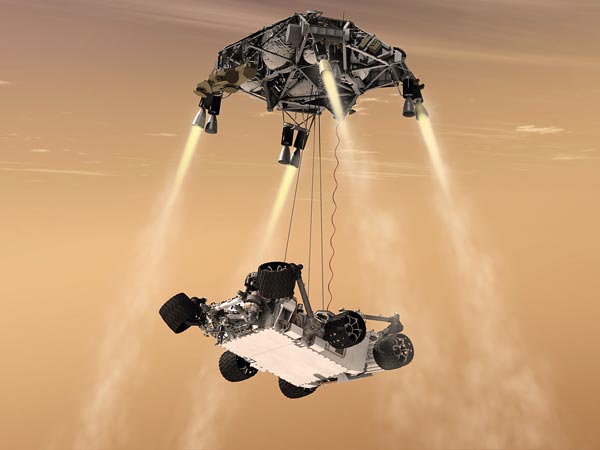
Curiosity, the big robot rover NASA is sending to Mars, looks in excellent shape for its Monday (GMT) landing.
Curiosity – also known as the Mars Science laboratory (MSL) – was launched from Earth in November last year and is now nearing the end of a 560-million-km journey across space.
To reach its intended touch-down zone in a deep equatorial crater, the machine must enter the atmosphere at a very precise point on the sky.
Engineers told reporters on Thursday that they were close to a bulls-eye.
A slight course correction – the fourth since launch – was instigated last Saturday, and the latest analysis indicates Curiosity will be no more than a kilometre from going straight down its planned “keyhole”.
The team’s confidence is such that it may pass up the opportunity to make a further correction on Friday.
“We are about to land a small compact car on the surface with a trunk-load of instruments. This is a pretty amazing feat getting ready to happen. It’s exciting, it’s daring – but it’s fantastic,” said Doug McCuistion, the head of NASA’s Mars programme.

Curiosity is the biggest and most sophisticated Mars rover yet.
It will study the rocks inside Gale Crater, one of the deepest holes on Mars, for signs that the planet may once have supported microbial life.
The $2.5 billion mission is due to touch down at 05:31 GMT Monday 6 August; 22:31 PDT, Sunday 5 August.
It will be a totally automated landing.
Engineers here at the Jet Propulsion Laboratory (JPL) in Pasadena, California, can only watch and wait.
The vast distance between Mars and Earth means there is a 13-minute lag in communications, making real-time intervention impossible.
NASA has had to abandon the bouncing airbag approach to making soft landings.
This technique was used to great effect on the three previous rovers – Sojourner, Spirit and Opportunity.
But at nearly a ton, Curiosity is simply too heavy to be supported by inflated cushions.
Instead, the mission team has devised a rocket-powered, hovering crane to lower the rover to the surface in the final moments of its descent.
Adam Steltzner, who led this work for NASA, said: “It looks a little bit crazy. I promise you it is the least crazy of the methods you could use to land a rover the size of Curiosity on Mars, and we’ve become quite fond of it – and we’re fairly confident that Sunday night will be a good night for us.”
The team is also keeping a sharp eye on the Martian weather and any atmospheric conditions that might interfere with the descent manoeuvres.
It is the equivalent of August also on Mars right now, meaning Gale Crater at its position just inside the southern hemisphere is coming out of winter and moving towards spring.
It is the time of year when winds can kick up huge clouds of dust, and a big storm was spotted this week about 1,000km from the landing site. But NASA expects this storm to dissipate long before landing day.
The first black-and-white images of the surface taken by Curiosity should be returned to Earth in the first hours after touch down, but the mission team do not intend to rush into exploration.
For one thing, the rover has a plutonium battery that should give it far greater longevity than the solar-panelled power systems on previous vehicles.
“This is a very complicated beast,” said Pete Theisinger, Curiosity’s project manager.
“The speech I made to the team is to recognize that on Sunday night at [22:32 PDT], we will have a priceless asset that we have placed on the surface of another planet that could last a long time if we operate it correctly, and so we will be as cautious as hell about what we do with it.”
Curiosity – Mars Science Laboratory:
• Mission goal is to determine whether Mars has ever had the conditions to support life
• Project costed at $2.5 billion; will see initial surface operations lasting two Earth years
• Onboard plutonium generators will deliver heat and electricity for at least 14 years
• 75 kg science payload more than 10 times as massive as those of earlier US Mars rovers
• Equipped with tools to brush and drill into rocks, to scoop up, sort and sieve samples
• Variety of analytical techniques to discern chemistry in rocks, soil and atmosphere
• Will try to make first definitive identification of organic (carbon-rich) compounds
• Even carries a laser to zap rocks; beam will identify atomic elements in rocks